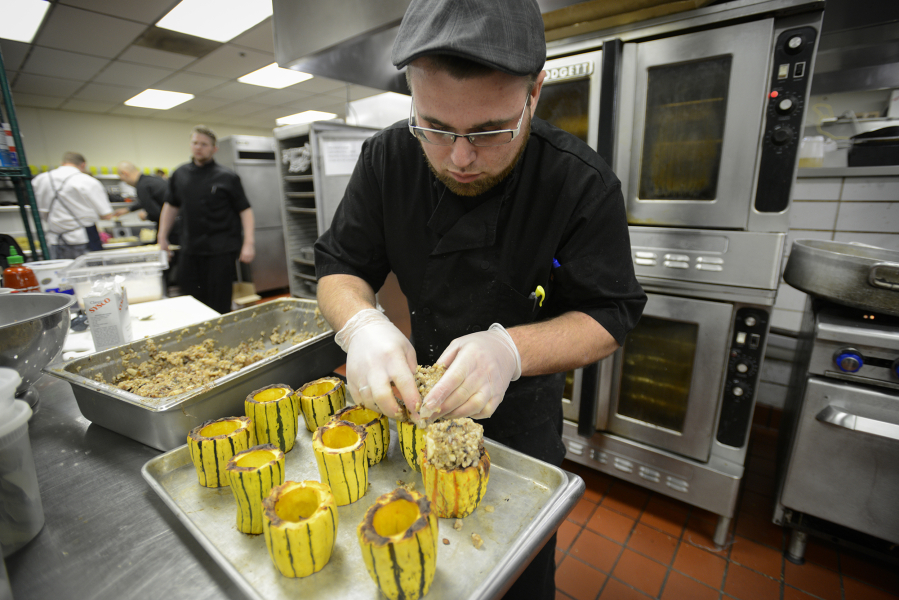Warren Neth wants to change the way you think about your food.
As the director of Slow Foods Southwest Washington, Neth and a team of chefs and farmers are working to shift the region’s food culture away from fast food and industry and back to farmers and local producers.
It’s a relatively new effort in Southwest Washington, Neth said. For years, the region has been in the shadow of Portland’s thriving farm-to-table movement. But the way Neth sees it, it’s about time that changed.
“I don’t think it’s really been a culture that got much traction,” Neth said.
Neth says that Southwest Washington, from the coast, north to Lewis County and east to Klickitat County, as having a rich culture of microclimates. That’s made a relatively small area ripe for growing a wide range of ingredients.
“We have amazing growing conditions, one of the best,” he said.
At the organization’s November fundraising dinner, Taste Renaissance, chefs from Southwest Washington converged on WareHouse ’23 to prepare a six-course feast featuring local ingredients. Each focused on one of the four microclimates Neth has identified: forest, coast, highlands and valley.
“We’re trying to develop a language about our food,” he said.
In the hours before the dinner, the kitchen was a whirlwind of activities. While the restaurants own chefs prepare diners’ lunches, a second crew of cooks are preparing delicata squash stuffed with wild mushroom stuffing, the fixings for a locally-sourced cheese plate and roasted Ozette potatoes.
That last item in particular has Neth bouncing on his heels. After the small, knobby fingerling potatoes were brought to Washington by South American explorers, they were cultivated by the native Makah Tribe in Neah Bay and flourished.
“It kind of went wild,” he said. “They haven’t been bred for size, but they have a really amazing flavor.”
Zac Janssen, executive sous chef at Skamania Lodge, was busy making a tempura batter for sliced leeks. They garnished an hor d’oeuvre of wild rabbit sausage, spaghetti squash sauerkraut and a thick huckleberry reduction.
As a cornerstone of the region’s food culture, Janssen too talked about the availability of local ingredients that can be foraged and hunted nearby — mushrooms, pheasants, berries, he listed off.
“As far as wild foraged, you won’t find anything like this in the United States as far as I’m concerned,” Janssen said, mixing the dry ingredients for his batter. “I think ours is closer to the farm-to-table, supporting the local guy, even utilizing what’s coming out of the forest.”
At a nearby station, Jodell Hinojosa made small cups full of wheat grass to garnish a cheese plate. Hinojosa and her husband head Jo Foody’s Catering, a company dedicated to including local flavors and ingredients in its food.
“There’s lots of different regions in Southwest Washington,” she said. “It’s pretty unique, at least around here.”
Hinojosa hopes Slow Foods Southwest Washington’s growing presence and increasing conversation about ingredients will draw people to consider where their food is coming from.
“It’s something I want to do so everyone else should just be like me,” she said with a laugh.
John Shuman and his wife, Marci Ebeling, were ahead of the curve to Southwest Washington’s growing food scene. The couple moved to Trout Lake in 2005 , where they opened artisan cheese company Cascadia Creamery.
“We wanted to get back to the land and be more in touch with our food, sustainability, self sufficiency,” said Shuman, head cheesemaker at the creamery. The couple’s cheeses were featured at the Slow Foods Southwest Washington dinner, and Ebeling was the featured speaker.
Shuman learned to make cheese from local dairies, trading free labor on farms for the opportunity to learn about the soil and the ingredients. But in doing that, Shuman said he found a food culture driven by people and producers.
“The people are driving,” he said. “The environment, the resources are facilitating.”
There’s a lot of talk in wine, about a growing region’s terroir, he said — the natural environment in which a wine is produced.
But what Southwest Washington has is a unique cultural terroir, he said, admitting it may sound a little kitschy. It’s the “culture of a place, the soul of a place,” that makes its food shine, he said.
“It’s this picture of a synergistic loop that works all together as a system,” he said. “It’s the people that eat it, the people that make it, but it’s also the soil and the environment and the knowledge that’s present. That’s the big picture.”




